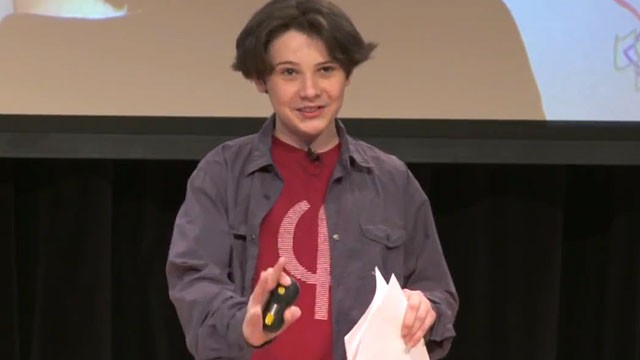Spend a couple of minutes with paternal twins Tyler and Trevor Parrish and you forget both are in wheelchairs.


Tyler and Trevor Parrish are the 2013 Students of the Year as named by the Alabama Governors Committee on Employment of People With Disabilities. They earned the honor through their work with NASA in the HUNCH program. This is the triple axis motion sensor the brothers created.

Tyler Parrish, right, and twin brother Trevor Parrish are the 2013 Students of the Year as named by the Alabama Governors Committee on Employment of People With Disabilities. They earned the honor through their work with NASA in the HUNCH program. Tyler and Trevor show the device they created, a motion sensor that detects movement along three axis. The brothers were photographed in their home in Decatur, Ala., Dec. 16, 2013.
*******************************************************************************
They don't refer to their muscular dystrophy as a disability, and the wheelchairs that have become their legs are just "the hand we have been dealt," Trevor said.
Pointing to his brain, Tyler said: "Nothing is wrong with this."
The 2013 graduates of Austin High School created a mock-up for the space station and earned the pair the state's Disability Students of the Year award. Gov. Robert Bentley honored the brothers, 19, during a ceremony in Montgomery last week.
The Alabama Governor's Committee on Employment of People with Disabilities has recognized students with disabilities since 1947. The committee is a branch of the Department of Rehabilitation Services, and its primary goals are to educate the public about the benefits of hiring people with disabilities and to promote independence for people with disabilities.
"It came as a surprise and I'm so proud of them," the twins' mother, Rhonda Parrish, said of the award.
The part the twins designed and milled at Austin High is a sensor they said can track movement on the space station. It took Tyler and Trevor three months to conceive and complete the project while they were students in the engineering program.
Family friend and engineer Robert Leke nominated the part for a regional award, which it won. The family thought that was the last recognition it would earn until the governor's office called.
"I was excited," Rhonda Parrish said. "It's just an honor to be recognized by the governor's office."
The road from St. Louis, Mo., where the twins were born, to Montgomery, where they received the award from Bentley, hasn't always been a smooth ride.
They moved to Decatur 15 years ago when their father, Mark, was transferred by Boeing.
Rhonda
said the twins showed no sign of muscular dystrophy when they enrolled
in the school system. Tyler, the oldest by a minute, was in third grade
when he began using a wheelchair regularly. Two years later, MD stripped
Trevor of his ability to walk.
They didn't complain then, and they still do not today.
"This does not bother me because I have found my purpose," Tyler said. "I'm here to be an encouragement to others. God has assured me, and I see this as a blessing."
Trevor shared his sentiment.
Muscular dystrophy is a genetic disorder that weakens the muscles that help the body move, according to the Mayo Clinic. Sufferers have incorrect or missing information in their genes, preventing them from making proteins needed for healthy muscles.
Despite the disease, Tyler and Trevor are not letting go of their dream of following in their father's footsteps.
Mark Parrish works at AAR SUMMA Technology in Huntsville as a computer numerical control programmer. He writes programs that mill parts for aircraft, they said.
The
twins said they are looking for a company that might let them work from
home or under the guidance of another programmer, preferably
their father.
"We want to contribute and not have society think we are a burden," Tyler said.
Source : Beaumont Enterprise,19th December 2013













 ATLAS is expected to spot half of the 160-foot asteroids in the solar
system and two-thirds of the 460-foot planet killers that are thought
to be floating around us. This would give people in the impact zone
anywhere from a few days to a few weeks to evacuate, depending on the
size of the rock. And though the system's detection rate will likely
never top 75 percent, it will coordinate with other space-based comet
catchers like the NEO and Pan-STARRS telescopes, which peer further but over a smaller swath of sky, to maximize their coverage. "We
want to put ourselves in the way of discovering the unexpected," Tonry
said. As such, the ATLAS should also be able to track more benign
astronomical events like supernovas, variable stars, gravity waves, and
asteroid impacts out in the Kuiper belt.
ATLAS is expected to spot half of the 160-foot asteroids in the solar
system and two-thirds of the 460-foot planet killers that are thought
to be floating around us. This would give people in the impact zone
anywhere from a few days to a few weeks to evacuate, depending on the
size of the rock. And though the system's detection rate will likely
never top 75 percent, it will coordinate with other space-based comet
catchers like the NEO and Pan-STARRS telescopes, which peer further but over a smaller swath of sky, to maximize their coverage. "We
want to put ourselves in the way of discovering the unexpected," Tonry
said. As such, the ATLAS should also be able to track more benign
astronomical events like supernovas, variable stars, gravity waves, and
asteroid impacts out in the Kuiper belt.